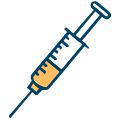You must not take Otezla if you are
allergic to apremilast or
to any of the ingredients in Otezla.
Otezla can cause allergic
reactions, sometimes severe.
Stop using Otezla and call your
healthcare provider or seek emergency help right away if you develop any of the
following symptoms of a serious allergic reaction: trouble breathing or
swallowing, raised bumps (hives), rash or itching, swelling of the face, lips,
tongue, throat or arms.
Otezla can cause severe diarrhea,
nausea, and vomiting, especially within the first few weeks of
treatment. Use in elderly
patients and the use of certain medications with Otezla appears to increase the
risk of complications from having severe diarrhea, nausea, or vomiting. Tell
your doctor if any of these conditions occur.
Otezla is associated with an
increase in depression.
In clinical studies, some patients reported depression, or suicidal behavior
while taking Otezla. Some patients stopped taking Otezla due to depression.
Before starting Otezla, tell your doctor if you have had feelings of depression,
or suicidal thoughts or behavior. Be sure to tell your doctor if any of these
symptoms or other mood changes develop or worsen during treatment with Otezla.
Some patients taking Otezla lost
body weight. Your doctor
should monitor your weight regularly. If unexplained or significant weight loss
occurs, your doctor will decide if you should continue taking Otezla.
Some medicines may make Otezla
less effective and should not be taken with Otezla. Tell your doctor
about all the
medicines you take, including prescription and nonprescription medicines.
The most common side effects of
Otezla include
diarrhea, nausea, upper respiratory tract infection, tension headache, and
headache. These are not all the possible side effects with Otezla. Ask your
doctor about other potential side effects. Tell your doctor about any side
effect that bothers you or does not go away.
Tell your doctor if you are
pregnant, planning to become pregnant or planning to breastfeed.
You
are encouraged to report negative
side effects of prescription drugs to the FDA. Visit www.fda.gov/medwatch, or call 1-800-332-1088.
Please click here for the
Full Prescribing Information for
Otezla.
APPROVED USES
Otezla® (apremilast) is a prescription medicine used to treat adult
patients with:
- Plaque psoriasis for whom
phototherapy or systemic therapy is appropriate.
- Active psoriatic
arthritis.
- Oral ulcers associated with
Behçet’s Disease.






